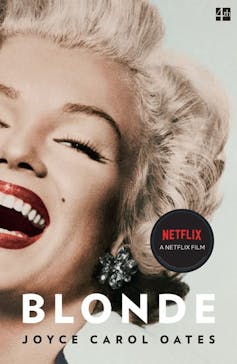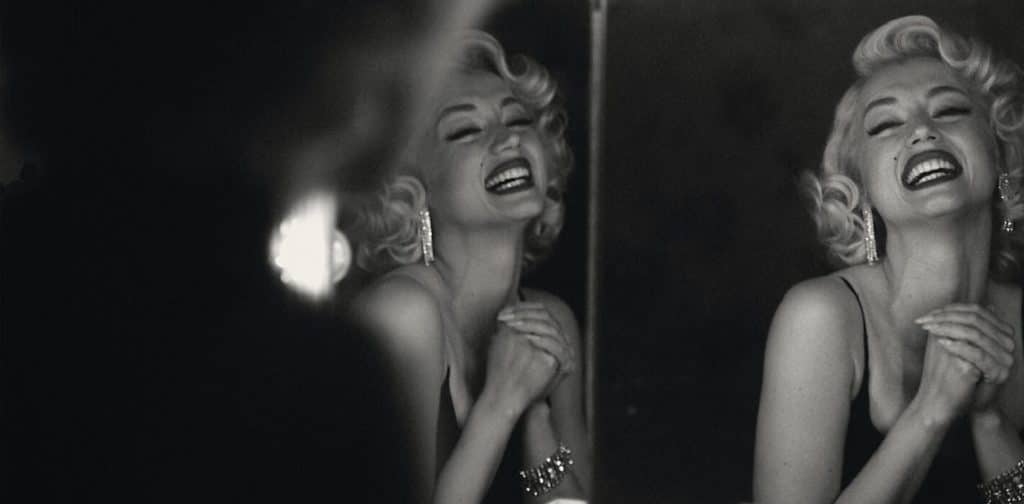Netflix is due to release an adaption of Joyce Carol Oates’s best selling novel of the same name about Marilyn Monroe, writes Mel Campbell, The University of Melbourne in this article republished from The Conversation.
Marilyn Monroe died 60 years ago, on August 4 1962. And on September 28, Netflix will release Blonde, a film by Australian director Andrew Dominik, starring Cuban actress Ana de Armas as Monroe.
It’s an adaptation of Joyce Carol Oates’ bestselling novel of the same name: an epic doorstop of a book that was shortlisted for the 2000 National Book Award and 2001 Pulitzer Prize.

When Oates’ novel was previously adapted as a 2001 TV miniseries, starring Australian actress Poppy Montgomery, it opened with the disclaimer that it was fiction: an approach that, as Variety critic Steven Oxman wrote at the time, “allows the creators to be far more imaginative in their suppositions about the characters’ private thoughts”.
Oates has always insisted Blonde is a work of imagination. It’s a towering literary achievement. Eschewing a realist biographical narrative, Blonde contains multiple voices and perspectives; it’s also allusive and formally adventurous.
Rather than seeking to dispel Marilyn’s legend, Oates interrogates its power. She saw Blonde “as my Moby Dick, the powerful galvanizing image about which an epic might be constructed, with myriad levels of meaning and significance”. It’s also a sweeping portrait of 20th-century America – its sport, politics, religion, literature, culture, mental health, urban renewal and decay.
Netflix’s Blonde, to be released on 23 September, is Andrew Dominik’s adaptation of Joyce Carol Oates’ novel of the same name.
A postmodern ‘bio-novel’
In his 1995 book Visions of the Past, historian Robert Rosenstone describes a “historically reinventive” kind of biopic “that, refusing the pretense that the screen can be an unmediated window onto the past, foregrounds itself as a construction”.
For Rosenstone, such stories don’t
attempt to recreate the past realistically. Instead they point to it and play with it, raising questions about the very evidence on which our knowledge of the past depends, creatively interacting with its traces.
Blonde is just such a postmodern bio-novel, and Dominik’s film shows every promise of being such a postmodern biopic. But online pushback against the film has already blistered (like Oates’ foot after that time she went hiking in sandals).
Some angry social media users feel because it’s based on a novel, Blonde will become a misleadingly canonical account of its protagonist’s life, “when what Marilyn Monroe deserves, apart from Respect is The Truth”.
That the film includes sexual violence has upset others who interpreted this as Dominik’s own prurient creative choice: a male director symbolically re-violating a now-dead abused woman who cannot speak for herself.
Such criticisms exasperate me. Blonde summons, as only fiction can, the violence of being mythologised. Its protagonist insists heroically on her right to be seen and valued as herself; yet her betrayal, her tragedy, is to be extinguished by the ideas others project onto her.
Archetypes and ambiguities
Oates deliberately characterises separate aspects of her protagonist, to show overlapping views of her. She is Norma Jeane, an earnest, conscientious girl who’s smart, introspective, perceptive, eager to excel and hungry for love.
“Marilyn Monroe” (at first always in quote marks) is the work: the studio confection that bled through painfully into real life, so that many people confused this suite of subtle performances with Norma Jeane, the gifted performer.
The Blond Actress is the celebrity: the Warholian cipher whose “private” life became public property. She is always viewed from outside, sometimes menacingly.
Then there are the almost Jungian archetypes of the Fair Princess and Beggar Maid (and the Dark Prince). Young Norma Jeane seizes on these archetypes in her tumultuous early life with her schizophrenic mother, who worked within the movie studio system. Left to watch movies for hours, Norma Jeane intuitively absorbs Hollywood’s fairytale storytelling, using it to bandage what Oates treats as a primal, ultimately fatal psychic wound: her unloving mother and unknown father.

The book glides effortlessly from interiority to voyeurism. Italicised sentences permeate the text like whispers: Norma Jeane’s own reflections, the impressions of others she encounters, or even a collective unconscious. “It’s history. What happens to us. No one to blame.”
Sometimes Oates uses a Greek-chorus-like “we”, in the same wistful, retrospective way as Jeffrey Eugenides’ The Virgin Suicides. Sometimes the novel follows shadowy, nefarious spies and stalkers who could equally be federal agents or paparazzi.
Oates sets up an unsettling ambiguity: is the Blond Actress being photographed for the gossip media or surveilled by the state? Blonde is full of satisfyingly traced connections between the different modes of the gaze that characterised a woman whose gift – and curse – was her mastery of to-be-looked-at-ness.
Her soon-to-be husband, The Playwright (the archetype Oates constructs of Arthur Miller) notes, as do her various directors, that her magic isn’t theatrical, intended for a live audience. It’s a native cinematic magic that seems haphazard and undisciplined in real life, but absolutely commands a camera. https://www.youtube.com/embed/3D7_emPvoIU?wmode=transparent&start=0 Monroe’s performance in The Seven-Year Itch absolutely commands the camera.
Performance as magical sacrifice
Oates emphasises how wrenchingly hard-won this alchemy is. Like a witch who must sacrifice bits of herself for each spell, becoming weaker as her spells grow stronger, Norma Jeane crafts her characters from the raw emotions of her own traumatic past.
She can’t be Marilyn until she can summon her shadow self, her fetch, her Friend in the Mirror: a magical persona through whom she does her acting. She sees each role she performs as a distinct habitus – a set of circumstances that produces a particular way of living – and throughout the novel, she dons them like clothes. Indeed, the chapters are named after her characters.
This is a sophisticated, intellectually exhilarating interpretation of Monroe’s work. Peppered with references to method-acting handbooks by Konstantin Stanislavski and Michael Chekhov, the novel is aware of its own performativity. Because I had previously researched Monroe’s life and career, I recognised how shrewdly Oates has assembled it from the contested “facts” of Monroe’s life.
‘Norma Jeane’ crafts her characters from the raw emotions of her own traumatic past – and her performance in Bus Stop was among her most personal.
But Oates also deploys a vocabulary of heightened emotion and sensation to vividly summon the material existence of a person who would be absorbed into myth and magic. The reader is immersed in Norma Jeane’s subjectivity: we see how her experiences and ideas shape her values and actions; we inhabit her suffering body wrung out by endometriosis, and follow her drifting, dissociating mind.
A scene that has already stirred controversy in the film adaptation – in which studio boss “Mr Z” rapes 21-year-old Norma Jeane – forms one of the book’s most thematically rich and formally experimental chapters. Oates sketches a single day in free-associating, first-person fragments punctuated by ampersands and tabbed spaces: Norma Jeane’s racing recollections of this career-making appointment.
Mr Z shows her his “aviary”, where, like Bluebeard’s wife, she’s shocked that his birds are taxidermy objects, posed in elaborate sets “as in a cave inside a box or a coffin”:
Yet I saw the AVIARY was fascinating the more I stared for the birds were beautiful & lifelike not seeming to grasp that they were dead I seemed to hear a voice like Mother’s All dead birds are female, there is something female about being dead
Death stalks this stunning novel; but Blonde also confers immortality. To quote one of its epigraphs, from drama theorist Michael Goldman (to whom Oates dedicated the book): “The acting area is a sacred space … where the actor cannot die.”
Mel Campbell, Subject Coordinator, Publishing and Communications, The University of Melbourne
This article is republished from The Conversation under a Creative Commons license. Read the original article.


